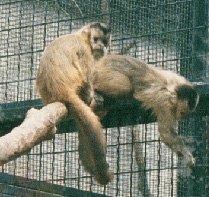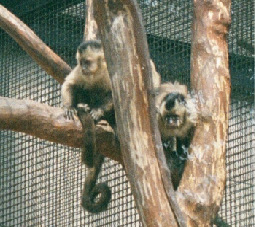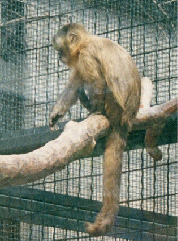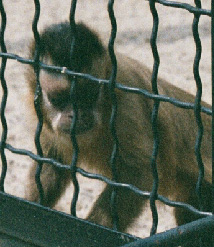Black-capped Capuchin (Cebus apella)
MORPHOLOGY:
This species has relatively long limbs compared to trunk size. The black-capped capuchin has a prehensile tail. This species is sexually dimorphic. Fingers on this species are short and the thumb is opposable (Fleagle, 1988). The premolars of the black-capped capuchin are large, and the molars are square shaped with a thick enamel to help with cracking nuts (Fleagle, 1988).
RANGE:
The black-capped capuchin is found in the countries of Argentina, Bolivia, Brazil, Colombia, Ecuador, French Guiana, Guyana, Paraguay, Peru, Suriname, and Venezuela. This species is usually found in humid forests below 500 meters. In Northern Argentina this species is found in montane forests from 200 to 1100 meters (Brown and Zunino, 1990). |
 |
 |
ECOLOGY:
The black-capped capuchin lives in trees in the understory zone which are 5-20 meters high and have a crown 10 meters in diameter (Janson, 1986). This species has been described to have an adaptable diet (Kinzey, 1997). The favorite fruit for this species in Peru is the Ficus and it also favors the Scheelea palm seeds (Kinzey, 1997). In Argentina at El Rey National Park the black-capped capuchin feeds on the foliage base of bromeliads (Brown and Zunino, 1990). This species is able to fed upon many nuts that Cebus albifrons can not forage for (Fleagle, 1988). In captivity the black-capped capuchin is able to learn how to use tools to manipulate food, much like Pan paniscus and Pan troglodytes, but not much evidence exists in the wild (McGrew and Marchant, 1997). Westergaard et al. (1997) found that the black-capped capuchin sometimes in captivity when presented with small branches to use as tools will try to extract ants from a container; this behavior has not been reported for in the wild. Black-capped capuchins were found in captivity to sometimes throw food at other groups, for to share food, and this throwing was aimed (Westergaard et al., 1998). The group sizes range from 10 to 35 individuals. |
LOCOMOTION:
The black-capped capuchin moves through the forest canopy quadrupedally and they use their prehensile tail during feeding (Fleagle, 1988). This species also occasionally leaps and climbs (Gebo, 1989).
SOCIAL BEHAVIOR:
The black-capped capuchin has polygamous mating system, although sometimes a subordinate male may copulate with a female (Kinzey, 1997). The social system found in this species is multimale-multifemale (Kinzey, 1997). This species has a matrilineal dominance hierarchy (Kinzey, 1997). The females of this species are philopatric and the males disperse (Kinzey, 1997). Social grooming is an important method of maintaining social bonds within the group. After a fight, it was found in captive black-capped capuchins that the individuals who fought sometimes reconciled with each other (they made up) (Verbeek and de Waal, 1997). However the researchers found that reconciliation did not occur, or occurred at a low frequency, after a contest competition (Verbeek and de Waal, 1997). This species sometimes forms mixed-species associations with Saimiri sciureus, and this could occur to increase feeding efficiency and for predator defense (Mendes Pontes, 1997). |
 |
VOCAL COMMUNICATION:
OLFACTORY COMMUNICATION:
VISUAL COMMUNICATION:
sleep posture: This is where a black-capped capuchin will lie on one side with the head drawn in and the body curled up into a ball. This is used to communicate submission.
staring open-mouth face: This is where the eyes are opened wide, the mouth is open with the teeth covered by the lips, and the eyebrows are lowered (Jolly, 1972). This occurs when mobbing a predator or serves to communicate an inhibited threat (Jolly, 1972).
staring bared-teeth scream face: This is where the eye are opened wide, the mouth is open with the corners drawn back so that the teeth and gums are revealed (Jolly, 1972). This display occurs with terror flight (Jolly, 1972).
silent bared-teeth face: This is where the eyes are staring at the stimulus, the eye brows are either relaxed or up, and the corners of the mouth are drawn back allowing the teeth to show (Jolly, 1972). This is used to communicate submission or a friendly approach (Jolly, 1972).
bared-teeth gecker face: This is like silent bared-teeth face only with a rapid noise attached to it (Jolly, 1972). This display occurs with defensive threat calls and during infant squeaks (Jolly, 1972).
lip-smacking face: This is where the eyes are opened wide, and the tongue is moving in and out of the mouth while the jaw is making sucking movements (Jolly, 1972). This is used as a greeting, during sex, and during grooming (Jolly, 1972).
tense-mouth face: This is where the eyes are opened wide, the mouth is narrowed to a slit, and the eyebrows are lowered (Jolly, 1972). This is used to communicate a confident threat or an attack (Jolly, 1972).
TACTILE COMMUNICATION:
social grooming: This is where one individual grooms another and is used to reinforce social bonds.
REPRODUCTION:
The black-capped capuchin gives birth to a single offspring.
REFERENCES:
Brown, A.D. and Zunino, G.E. 1990. Dietary Variability in Cebus apella in Extreme Habitats: Evidence for Adaptability. Folia Primatologica Vol. 54, 187-195.
Burton, Frances. 1995. The Multimedia Guide to the Non-human Primates. Prentice-Hall Canada Inc.
Fleagle, John G. 1988. Primate Adaptation and Evolution. Academic Press.
Gebo, D.L. 1989. Locomotor and Phylogenetic Considerations in Anthropoid Evolution. Journal of Human Evolution Vol. 18(3), 201-233.
Janson, C.H. 1986. Ecological and Social Consequences of Food Competition in Brown Capuchin Monkeys. Unpublished Ph.D. dissertation, University of Washington, Seattle.
Jolly, A. 1972. The Evolution of Primate Behavior. Macmillan Publishing Co., N.Y.
Kinzey, W.G. 1997. Cebus. in New World Primates: Ecology, Evolution, and Behavior. ed. Warren G. Kinzey, Aldine de Gruyter, New York.
McGrew, W.C. and Marchant, L.F. 1997. Using the Tools at Hand: Manual Laterality and Elementary Technology in Cebus spp. And Pan spp. International Journal of Primatology Vol. 18, 787-810.
Mendes Pontes, A.R. 1997. Habitat Partitioning Among Primates in Maraca Island, Roraima, Northern Brazilian Amazonia. International Journal of Primatology Vol. 18, 131-157.
Verbeek, P. and de Waal, F.B.M. 1997. Postconflict Behavior of Captive Brown Capuchins in the Presence and Absence of Attractive Food. International Journal of Primatology Vol. 18, 703-725.
Westergaard, G.C., Kuhn, H.E., Babitz, M.A., and Suomi, S.J. 1998. Aimed Throwing as a means of Food Transfer Between Tuted Capuchins (Cebus apella). International Journal of Primatology Vol. 19, 123-131.
Westergaard, G.C., Lundquist, A.L., Kuhn, H.E., and Suomi, S.J. 1997. Ant-gathering with Tools by Captive Tufted Capuchins (Cebus apella). International Journal of Primatology Vol. 18, 95-103. |

 |
Last Updated: October 6, 2003.
[The Primata] [Primate Fact Sheets] [Family Cebidae] [Cebus Links]




